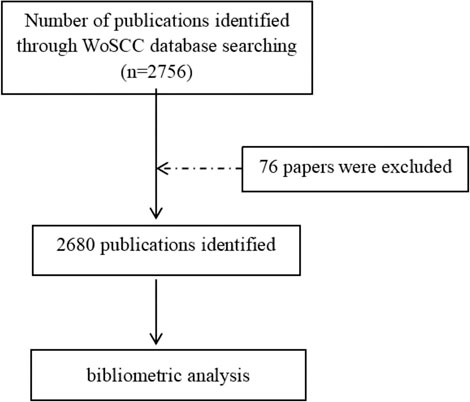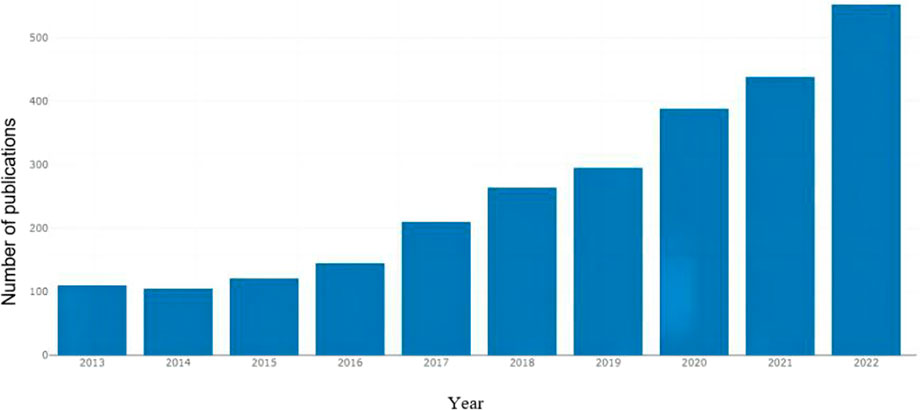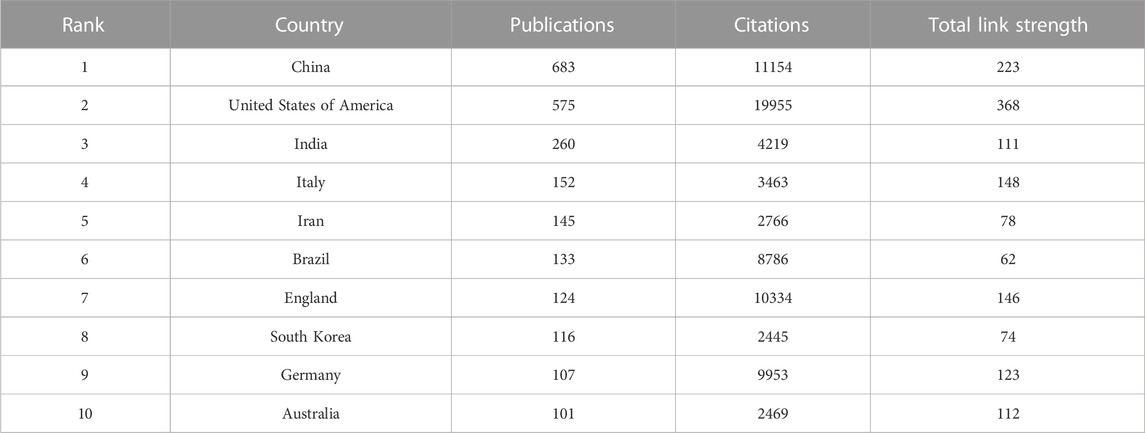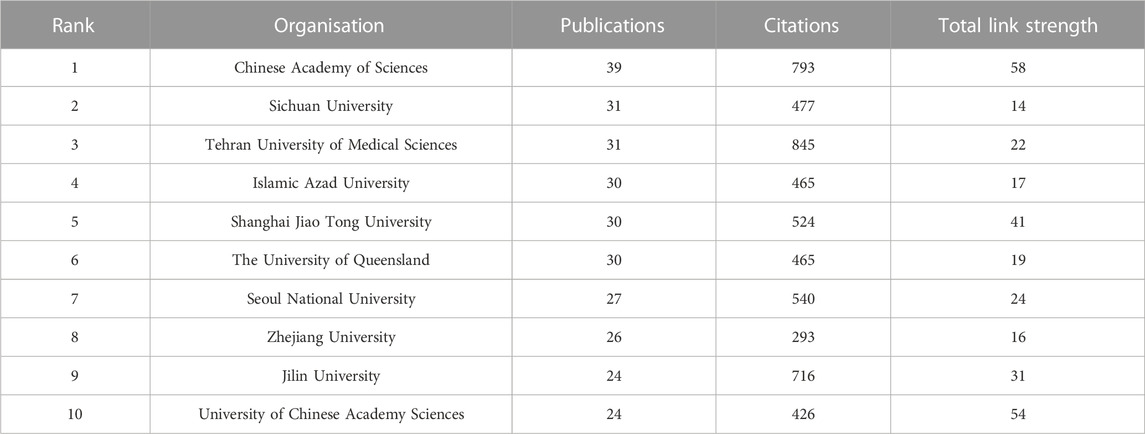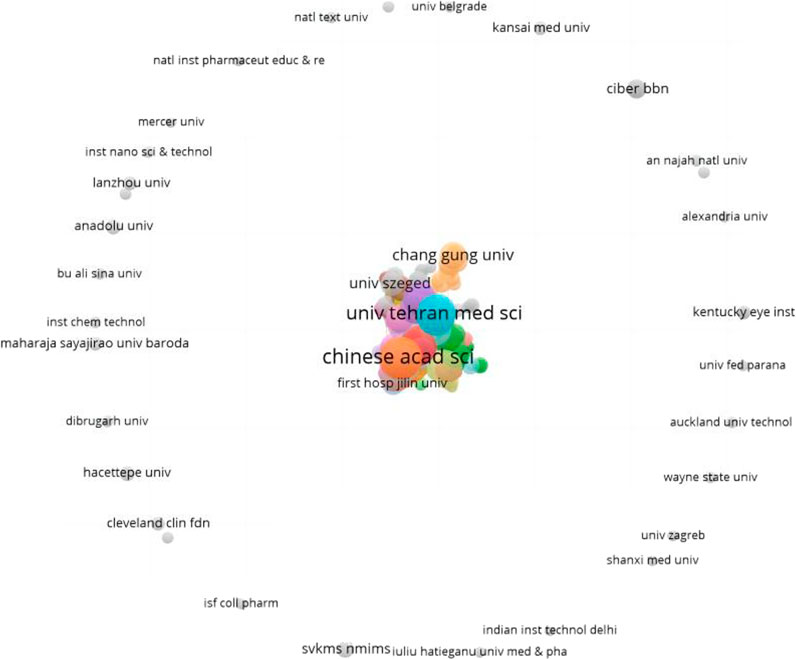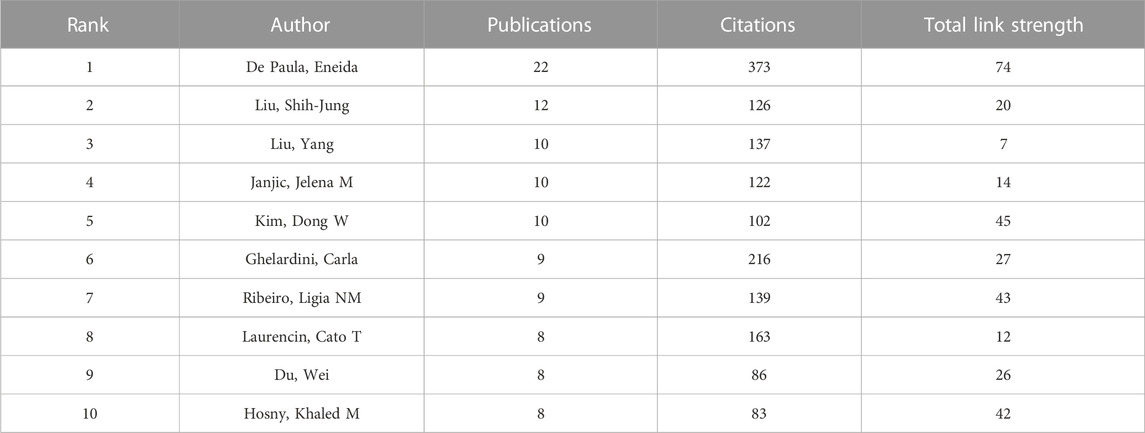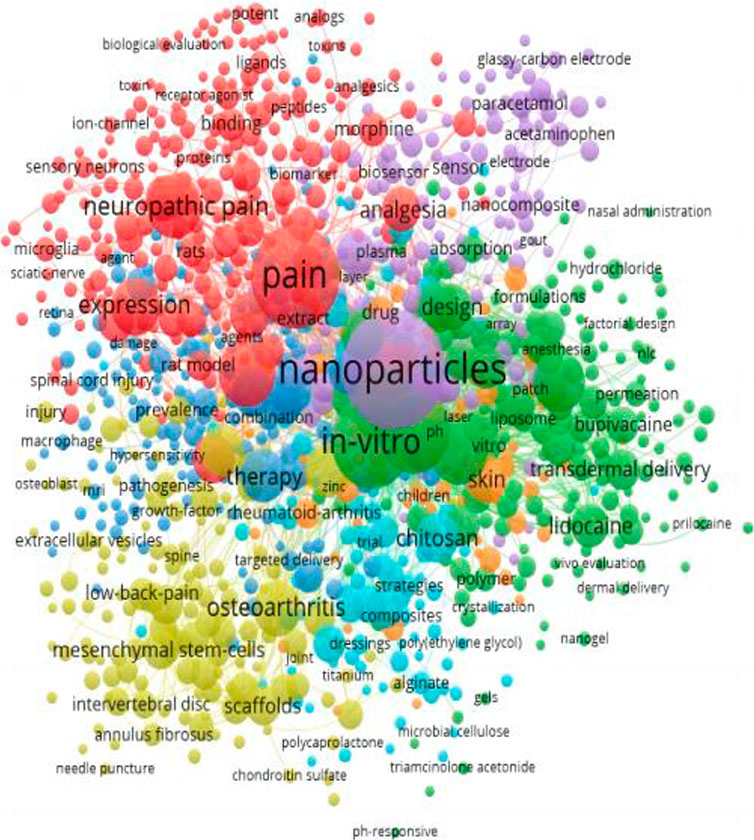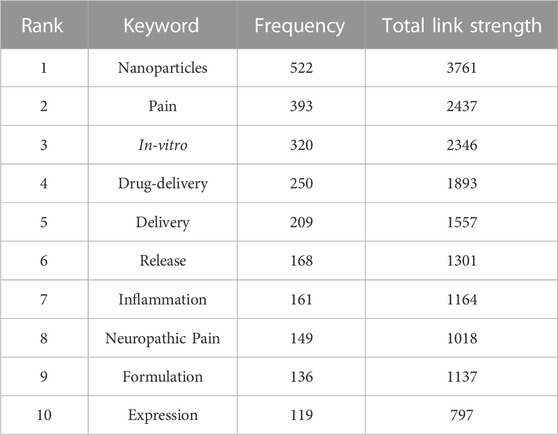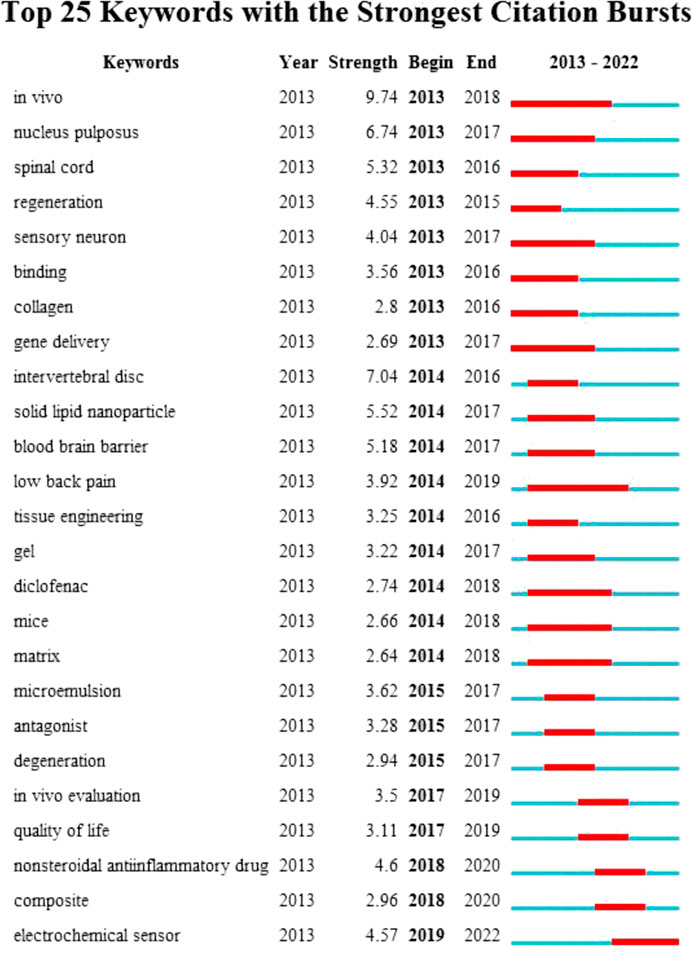Global research trends of nanotechnology for pain management
- Department of Anesthesiology, Hunan Children’s Hospital, Changsha, China
Background: Nanotechnology has been increasingly used in healthcare during recent years. However, the systematic evaluation of research on nanotechnology for pain management is lacking. In this study, we employed a bibliometric approach to examine the status of the research and global trends of nanotechnology in relation to pain management.
Methods: We selected relevant papers published in the Web of Science Core Collection database between 2013 and 2022 using search terms related to nanotechnology and pain management. Subsequently, the following bibliographic information was collected: publication year, originating country/region, affiliated authors and institutions, published journal, references cited, citation frequency, and keywords. The bibliometric software programs VOSViewer and CiteSpace were employed to obtain bibliometric statistics and perform visual analysis.
Results: A total of 2680 papers were retrieved. The number of publications in the field of nanotechnology for pain management has been increasing annually since 2013. China had the highest number of published papers, whereas the United States led in total citations. The Chinese Academy of Sciences was the most prolific institution, while the Tehran University of Medical Sciences had the highest overall citations. Furthermore, De Paula was the most prolific author. Papers associated with nanotechnology for pain management were mainly published in the International Journal of Pharmaceutics, Pharmaceutics, and the International Journal of Nanomedicine. Keyword analysis showed that “in-vitro” and “drug-delivery” appeared most frequently, with the top 10 common keywords comprising nanoparticles, pain, in-vitro, drug-delivery, delivery, release, inflammation, neuropathic pain, formulation, and expression. Lastly, the latest emerging keyword was “electrochemical sensor”.
Conclusion: Research on applying nanotechnology for pain management is growing steadily. China is the top country in terms of number of publications, with institutions under the Chinese Academy of Sciences making significant contributions to this field. “In-vitro” and “drug-delivery” are the current hotspots in this area, with “electrochemical sensor” as the latest topic at the research forefront. However, national and inter-institutional collaborations should be strengthened to enable patients with pain disorders to benefit from nanotechnology implementation in pain management.
Introduction
Pain is an extremely common symptom observed in clinical practice. Patients with complex and challenging conditions that result in severe acute or chronic pain often experience serious physiological and psychological effects in various aspects of their life or work (Hylands-White et al., 2017; Cornish and Cornish, 2020; Fitzcharles et al., 2021). In terms of sensation, pain is an unpleasant emotional experience that can also cause mental distress. From a biological perspective, pain is an obvious signal of damage onset, indicating that a certain body part has been injured or is in imminent harm. Pain constitutes a physiological process in which certain molecules undergo signal transduction to produce pain responses (Wicksell et al., 2017; Wilson, 2017). Nociceptive, inflammatory, and neuropathic pain are the three general categories of pain. Although pain is a widespread and harmful phenomenon, its current treatment methods are relatively limited. Moreover, a patient with chronic pain will undergo overwhelming mental trauma, requiring pain alleviation via medication or other interventions (Hagiwara et al., 2020; Hoehn et al., 2022).
Common analgesics to treat chronic pain in clinical practice include non-steroidal anti-inflammatory drugs (NSAIDs) and morphine-based painkillers (Shaheed et al., 2020). However, many complications and side effects have resulted from the long-term and/or large-dose administration of these drugs. NSAIDs can cause stomach pain, nausea, or indigestion, while some patients may experience headaches, drowsiness, or insomnia. Furthermore, prolonged opioid use can lead to tolerance, dependence, and even respiratory depression in large doses (Vadivelu et al., 2018). The application of nanotechnology can effectively reduce the side effects of pain medications and mitigate tolerance development, thereby improving treatment efficiency. Different pain drugs can be loaded onto various nanocarriers, including natural, synthetic, and copolymer nanocarriers, for different medical interventions (Mendoza and Arruebo, 2020; Song et al., 2022). The development of nanotechnology has facilitated the emergence of pain relief strategies utilising various nanomaterials and targeted surface modifications. Furthermore, nanomaterials not only function as drug delivery carriers but can also be deployed to relieve chronic pain via the gradual release of pain medication, thus prolonging the duration of pain relief (Wu et al., 2020; Yu et al., 2022). Therefore, nanomaterials may provide many benefits for pain management. However, implementing nanotechnology in pain management requires further elucidation to yield the appropriate benefits to patients with pain conditions and even avoid potential adverse outcomes. Although scientists have investigated the use of nanotechnology in treating patients with pain disorders, the available literature on nanotechnology for pain management is not well integrated. Considering this issue, a systematic study is required to summarise the current state of research on nanotechnology applications in patients with pain disorders.
Bibliometrics is a popular and important scientific research tool applicable to all disciplines, including biomedicine (Chen and Song, 2019). Bibliometric analysis is a well-known research method based on mathematics and statistics used to evaluate academic productivity, reveal the status and hotspots in a particular discipline, and predict scientific trends in the study field according to the metrological characteristics of the relevant literature in various databases. This depth of analysis is not achievablein single-centre studies and reviews (Huang et al., 2022; Li L. et al., 2022; Li X. et al., 2022; Guan et al., 2023). Additionally, bibliometric software, such as VOSViewer, can be used to generate maps with high aesthetics and readability. Moreover, VOSViewer has a friendly user interface and is easy to operate and suitable for beginners. Another software tool CiteSpace offers a wealth of parameter settings and customisation options, allowing users to utilise flexible settings and perform analyses according to their own research needs. Furthermore, bibliometric and visual analyses enable the illustration of textual information in terms of the contributions and collaborations of different countries or regions, institutions, journals, and authors, improving the interpretability of this information (Liu L et al., 2022). Both these software were used in this study, enhancing the presentation and accuracy of the data analysis. As mentioned earlier, although research on nanotechnology for pain management is growing, no systematic analysis of the related literature is currently available. Therefore, this study provides a bibliometric and visual analysis of the literature on nanotechnology for pain management over the last decade (2013–2022), with an aim to improve the understanding of the present state of this research field, provide a forecast of topics of interest to scholars worldwide, and shed light on the future trends.
Materials and methods
Data sources
The Web of Science (WoS) database, created by the Institute for Scientific Information, was used as the data source. The search words were set to TS = (Nano*) AND TS = (pain OR analgesia) AND PY = (2013–2022) to screen for literature on nanotechnology for pain management published in the past decade (2013–2022). The literature search was performed on 21 March 2023. All bibliographic data were stored in plain text and included information such as keywords, source country/region, author and institution affiliation, publication journal, references cited, and citation and keyword frequency (Figure 1). The restricted types of literature searched were treatises and reviews, excluding other literature types such as newsletters and abstracts.
Data screening and visualisation
Two independent technical staff members conducted the literature screening and data collation separately. Annual publication trends, national/regional distribution, source journals, references, frequency of papers cited, and keywords were extracted and analysed from the screened literature. A bibliometric statistical and visual analysis was performed using VOSViewer 1.6.18 and CiteSpace 5.7.R2.
Results
Annual publication output
A total of 2680 eligible papers on nanotechnology for pain management published during the past decade (2013–2022) were retrieved from the WoS Core Collection (WoSCC) database (Figure 1), which received 53489 total citations. Among the 2680 publications, 1101 were articles, and 166 were reviews. As shown in Figure 2, the number of publications in the research field of nanotechnology for pain management has been increasing annually since 2013.
National and regional productivity
A total of 95 countries/regions have published papers on nanotechnology applications in pain management. Table 1 lists the most productive countries/regions according to the number of publications. China was the most productive country (683 papers), followed by the United States (USA; 575 papers) and India (260 publications). The USA, China, and England were the most influential countries, with their papers being collectively cited 8729, 2214, and 1034 times, respectively. The annual trends in the publication output among the top 10 most productive countries are depicted in Figure 3. The distribution of papers by country and region is presented in Figure 4.
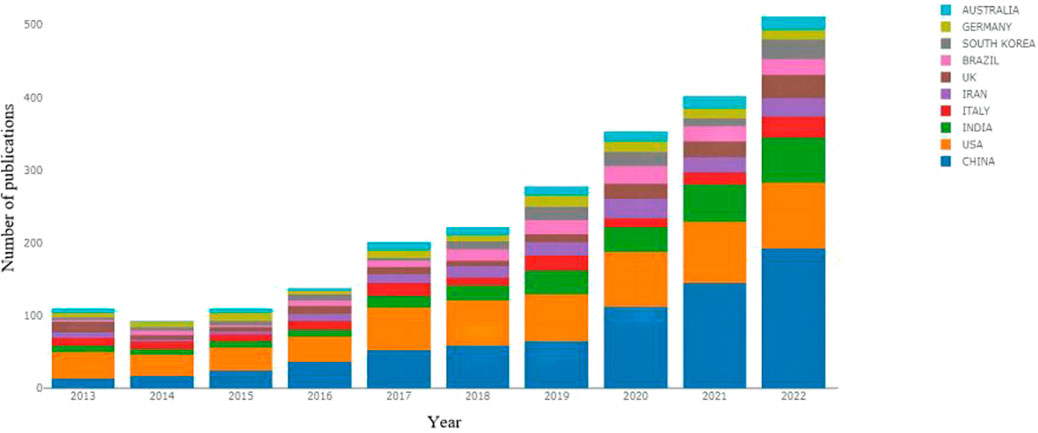
FIGURE 3. Annual publication trends among the top 10 countries in the field of nanotechnology applications for pain management.
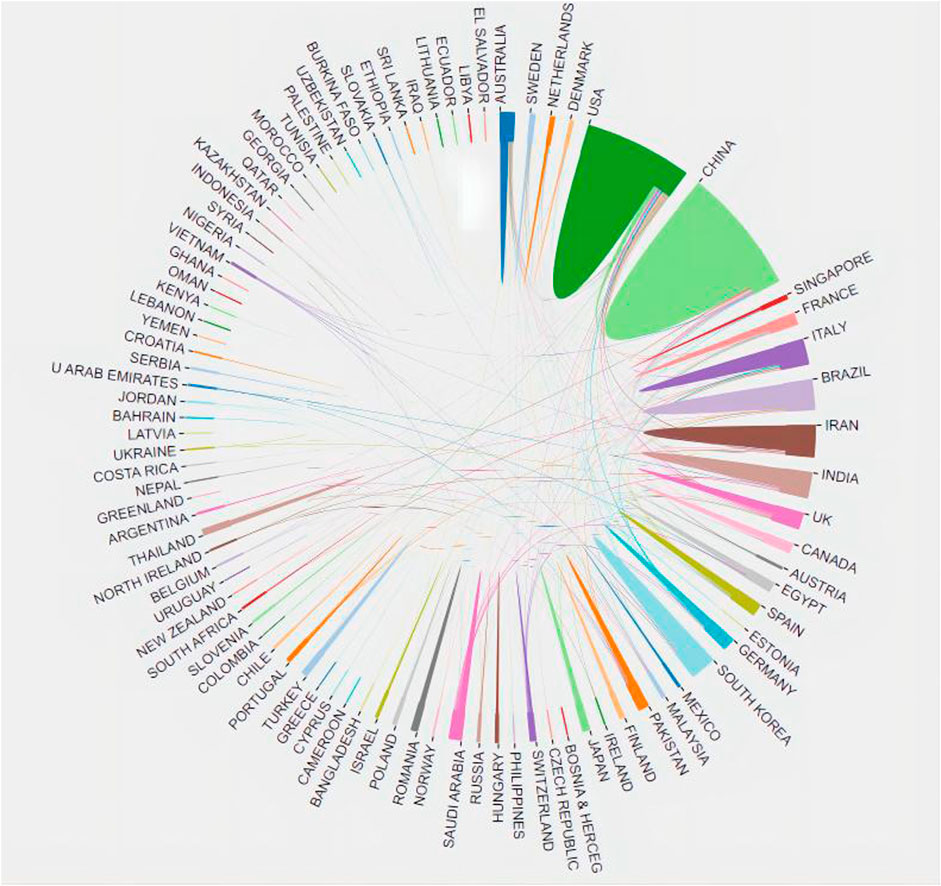
FIGURE 4. Publications and collaborations in the field of nanotechnology for pain management according to country/region.
Institutional contributions
A total of 3492 different institutions were involved in the research on nanotechnology for pain management, with at least five papers published by 273 institutions. The top 10 most active institutions are listed in Table 2, including six in China and two in Iran. The Chinese Academy of Sciences (China) was found to be the most productive institution, with 39 published papers. The next two institutions were (Sichuan University in China and the Tehran University of Medical Sciences in Iran), contributing 31 publications each. The Tehran University of Medical Sciences, the Chinese Academy of Sciences, and Jilin University were the most influential institutions, with their papers receiving 845, 793, and 716 citations, respectively. Figure 5 presents the distribution and collaboration of the institutions.
Authors’ contributions
A total of 15186 authors contributed to the research on nanotechnology for pain management. The visual analysis of the core authors is shown in Figure 6, while the top 10 authors with the highest number of publications are listed in Table 3. The analysis revealed that De Paula, Shih-Jung, and Yang were the most prolific authors, accounting for 22, 12, and 10 publications, respectively. In terms of citation frequency, De Paula, Ghelardini, and Laurencin were the most cited authors, with their papers receiving 373, 216, and 163 citations, respectively.
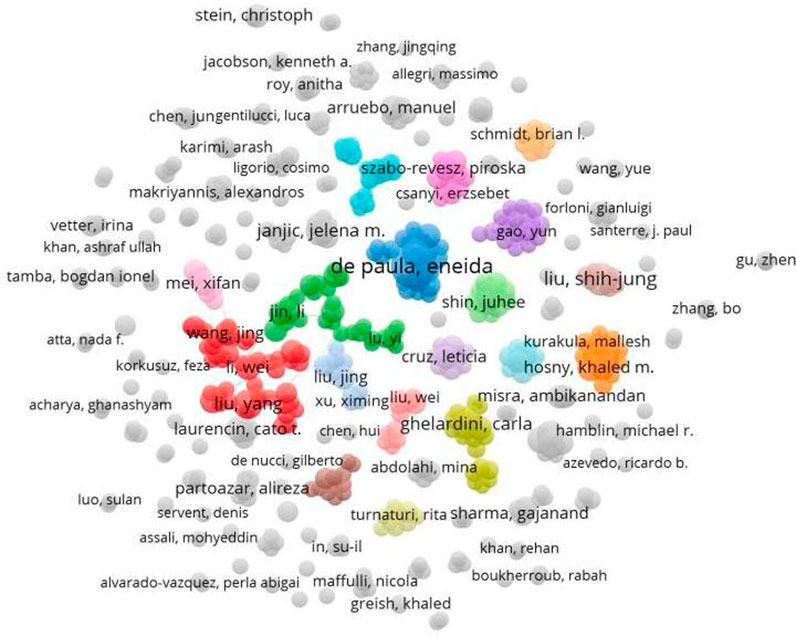
FIGURE 6. Collaboration network map of authors in the research field of nanotechnology for pain management.
Journal analysis
A total of 982 journals have published papers related to nanotechnology for pain management, and the visual analysis of major journals is shown in Figure 7. The International Journal of Pharmaceutics was the most active, with 29 published papers. The next two journals were Pharmaceutics and the International Journal of Nanomedicine, publishing 17 and 16 papers, respectively (Table 4).
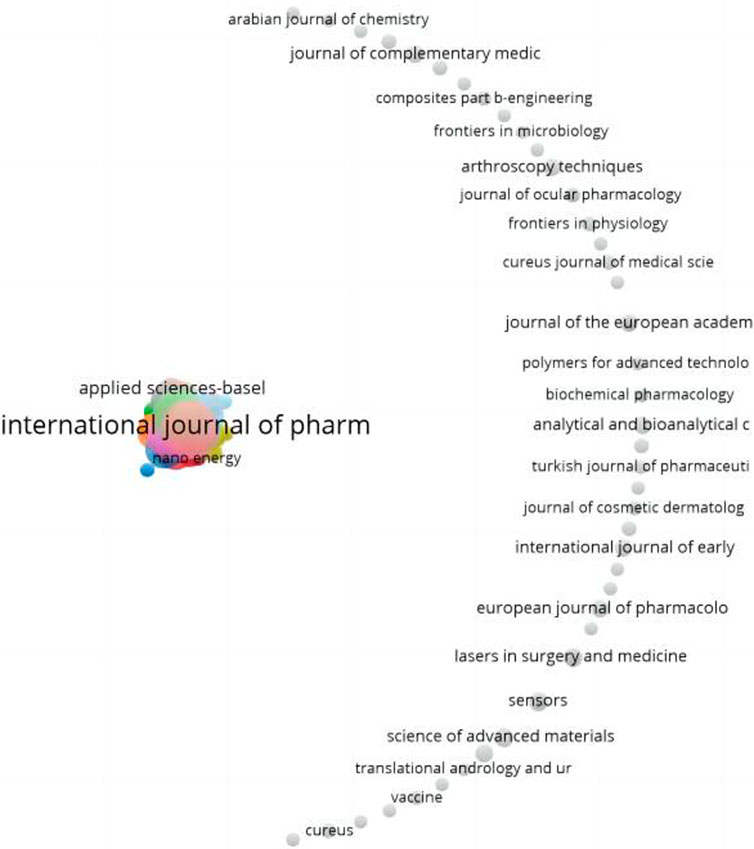
FIGURE 7. Collaborative network of journals in the research field of nanotechnology for pain management.
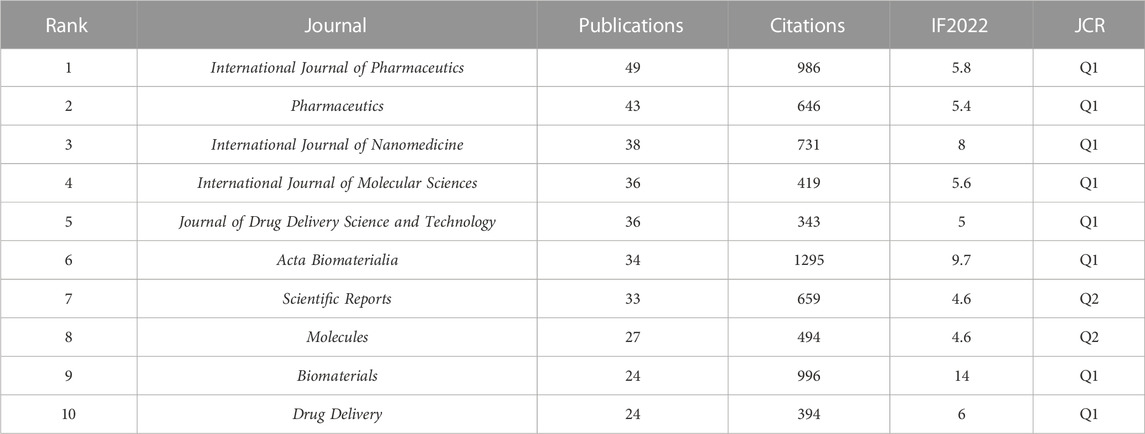
TABLE 4. Top 10 journals with the most publications in research on nanotechnology for pain management.
Keyword analysis
Keywords are condensed representations of the literature in a particular field, with high-frequency keywords in multiple papers considered research hotspots. The keywords in the identified literature were summarised and filtered for high-frequency sub-terms. The resulting keywords are illustrated in Figure 8. The statistical analysis revealed 13033 keywords in 2680 papers. The top 10 most frequently occurring keywords, including nanoparticles, pain, in-vitro, drug-delivery, delivery, release, inflammation, neuropathic pain, formulation, and expression, are displayed in Table 5. After the subject terms, ‘in-vitro’ was the most frequently used keyword (320 co-occurrences), followed by ‘drug-delivery’ (250 co-occurrences), consistent with the theme of our study. Figure 9 shows the results of a keyword emergent analysis. The most recent keyword to standout was ‘electrochemical sensor'. Further analysis shows that early research focused on the analgesic effect of nanoparticles at the spinal cord level, and then the research hotspot shifted to the pain-relieving effect of nano-formulations of non-steroidal anti-inflammatory drugs (NSAIDs), and in the last few years scholars have paid more attention to the hotspot of electrochemical sensing technology.
Discussion
The rapid development of nanotechnology has been accompanied by the establishment of medicine as an important area of nanotechnology applications. However, nanotechnology implementation in pain management is only in its nascent stage. The biggest challenges in pain management using medications comprise their limited duration of action and side effects (Chakravarthy et al., 2017; Bidve et al., 2019). The adoption of nanotechnology has helped patients with pain disorders to access comparatively better healthcare because nanotechnology systems overcome many problems encountered in using conventional analgesics. The use of nanomaterials and nanoparticles can achieve pain management at the molecular level, leading to improved outcomes, reduced analgesic drug doses, and enhanced long-term efficacy and safety (Chen et al., 2020; Da Silva et al., 2022; Dash and Kundu, 2023). In recent years, nanotechnology research for pain management has increased, playing a crucial role in advancing the relevant nanotechnology strategies (Kopach et al., 2018; Kuthati et al., 2020). From 2013 to 2022, 2680 papers have been published. However, a systematic analysis and summary of the research and literature in this domain have been lacking. Furthermore, the development of computer search techniques and the growth of bibliometric analysis enable us to digitally retrieve and analyse information concerning the research findings on nanotechnology for pain management. In this study, current literature data on nanotechnology for pain management was analysed bibliometrically and visually from an information science perspective.
China is the leading country with the highest number of published papers, indicating that it is at the forefront of research on nanotechnology for pain management. This observation may be attributed to the health strategy implemented by China. Moreover, China has a government-led and policy-supportive approach in the field of nanotechnology, promoting the development of nanotechnology through financial investments and talent recruitment. With the support of government funding, the research, development, and industrialisation of nanopain medicine technology have gradually developed, leading to the growth of many prominent companies and research teams (Duschl and Windgasse, 2018). In the case of the USA, nanotechnology research was initiated comparatively earlier; therefore, this field has a strong basic research foundationin this country. Currently, the USA focuses more on technical research and commercialisation in this domain, supporting the development of the nanotechnology industry via research funding and national laboratories. Additionally, the USA has some of the world’s leading research institutions, with excellent research conditions as well as laboratory equipment and tools to foster high-quality nanomedicine research. Moreover, the USA has a strong industrial base in the medical devices, pharmaceuticals, and biotechnology sectors, and these industries strongly support nanomedicine research (Shen et al., 2017; Qiuyue et al., 2023). Lastly, nanotechnology use in the USA patient population with pain conditions is relatively well established. Although the field of nanotechnology for pain management has attracted worldwide attention, co-operation between different countries in this research field is limited. Therefore, international co-operation within this domain requires to be strengthened.
The number of publications, citations, and keyword co-occurrences is an important indicator of the centrality and scientific collaborations of an institution in a particular research field as well as reflects the academic level of the country where the institution is located. Here, six of the top 10 institutions in research on nanotechnology for pain management were from China, confirming China’s prominence in this field. The Chinese Academy of Sciences in China was the most prolific institution, with 28 publications and the highest number of total citations. Of the 15,186 authors contributing to the research on nanotechnology for pain management, De Paula was the most influential author, with 22 published manuscripts and 373 citations overall. In the case of the journals in this domain, most publication journals were medical journals. Papers on nanotechnology for pain management were mainly published in the International Journal of Pharmaceutics, Pharmaceutics, and the International Journal of Nanomedicine. These highly productive journals have contributed to the global development of the field of nanotechnology for pain management.
Keyword analysis is a vital aspect of bibliometric analysis, summarising the paper content and visually expressing the research direction and publication topic. Nanotechnology can benefit patients with pain conditions, and the most frequent keywords in our analysis were ‘in-vitro’ and “drug-delivery”, suggesting that nanotechnology-based drug-delivery in pain management is a significant research topic. The employment of nanotechnology for drug delivery can help address the issues of limited duration of action and side effects of the existing pain medications. Nanocarriers have been demonstrated to facilitate drug delivery to the target site at an appropriate level, thereby reducing systemic toxicity (Berrocoso et al., 2017; Hua and Wu, 2013). Specific drugs delivered in nanocarriers for pain relief include local anesthetics, nonsteroidal anti-inflammatory drugs, opioids, and others. Thus, nanotechnology use for drug delivery may improve therapeutic efficiency, reduce drug side effects, and mitigate tolerance development. Different pain medications have been loaded onto different nanocarriers, including natural, synthetic, and copolymer nanocarriers, for various medical purposes (Khazraei et al., 2017; Wang et al., 2022). Pain relief strategies using varied nanomaterials and targeted surface modifications have grown rapidly with nanotechnology advances. Burst terms are new words or terminologies that exhibit a rapid increase in frequency in a specific topic or field within a certain period, effectively reflecting the hot changes in that particular research area. In this study, “electrochemical sensor” was identified as a recent burst term, indicating that this topic is an emerging research Frontier in the field of nanomaterials for pain management and warrants further investigation. Furthermore, nanoparticles can be used to detect the source of pain signals. The injection of nanoparticles locally into the pain site may help to accurately identify the source of pain molecules by localising and tracking neurotransmitter secretion in vivo (Tronino et al., 2016; Khanna et al., 2021; Qiao et al., 2023). This approach enables the precise targeting of pain treatment, representing the latest advancements in nanotechnology in this field. Due to various constraints, most of the existing studies on nanocarriers in the field of pain management are still at the preclinical research stage, and the more researched ones that are now on the market include Exparel, a bupivacaine liposome-infused suspension, which has been approved by the FDA in the United States.
Although nanotechnology applications in pain management have developed greatly, several challenges and limitations remain. A few issues that require further investigation include ensuring the reliability and safety of nanotechnology for pain management and integrating nanotechnology with traditional medical practice. Additionally, nanotechnology use in pain management requires close collaboration between specialists and other support staff. Attention also needs to be paid to the transparency and interpretability of nanotechnology to enable physicians and patients to comprehend and accept the results obtained from implementing nanotechnology. Nevertheless, applying nanotechnology in pain management appears promising and may improve outcomes and quality of life for patients with pain disorders.
Although nanotechnology offers many advantages, combining pain medication with nanotechnology is relatively expensive, resulting in certain difficulties in its widespread adoption across different countries and regions worldwide. Nevertheless, future developments in nanotechnology will facilitate its widespread deployment. Moreover, nanotechnology for pain management should be considered an evolving process, and the choice of nanotechnology should factor in the analgesic effects and economic costs. Overall, nanotechnology use in pain management has wide application potential and far-reaching implications. Furthermore, the continuous development and improvement in nanotechnology will serve as an important driving force in pain management research, enhancing the health security and quality of life in patients with pain conditions worldwide.
Limitations
This study has several limitations that should be considered. First, the bibliometric analysis results are influenced by the data source, with certain variations in the literature included in each database. The database we used was WoSCC; therefore, the publications in non-English language databases were not included. Nonetheless, the WoSCC database is a leading global literature database with high-quality literature across the world, making it an ideal database for bibliometric studies. Second, bibliometric research relies heavily on the citation relationships of published literature to infer collaborations among scholars and connections between research fields. However, the citation behaviour of researchers is influenced by numerous factors, including author status, publisher reputation, and journal impact factor. Thus, bias may occur when analysing social networks and disciplinary intersections in bibliometric examination.
Conclusion
Our study is the first to visually analyse the current state and future trends in nanotechnology research for pain management. Overall, this research field is in a rapidly evolving phase. China is the leading research country, with institutions affiliated with the Chinese Academy of Sciences having significant contributions. ‘In-vitro’ and “drug-delivery” are the current research focus, and ‘electrochemical sensor’ is at the research forefront. However, national and inter-institutional collaboration should be strengthened to enable patients with pain disorders to benefit from nanotechnology advancements. This study will serve as a useful reference for further research on nanotechnology applications for pain management.
Data availability statement
The original contributions presented in the study are included in the article, further inquiries can be directed to the corresponding author.
Author contributions
YZ and YY designed this study, performed the analysis, and normalized the pictures. YY and RK collected the data. YZ and YY wrote the original draft. ZC and ZD revised the manuscript. SQ supervised this study. All authors contributed to the article and approved the submitted version.
Funding
This study was supported by a grant from the project “Scientific Research Project of Hunan Provincial Health Commission” (Grant: 20200802).
Conflict of interest
The authors declare that the research was conducted in the absence of any commercial or financial relationships that could be construed as a potential conflict of interest.
Publisher’s note
All claims expressed in this article are solely those of the authors and do not necessarily represent those of their affiliated organizations, or those of the publisher, the editors and the reviewers. Any product that may be evaluated in this article, or claim that may be made by its manufacturer, is not guaranteed or endorsed by the publisher.
References
Bidve, P., Prajapati, N., Kalia, K., Tekade, R., and Tiwari, V. (2019). Emerging role of nanomedicine in the treatment of neuropathic pain. J. Drug Target. 28, 11–22. doi:10.1080/1061186x.2019.1587444
Chakravarthy, K. V., Boehm, F. J., and Christo, P. J. (2017). Nanotechnology: a promising new paradigm for the control of pain. Pain Med. 19, 232–243. doi:10.1093/pm/pnx131
Chen, C., and Song, M. (2019). Visualizing a field of research: a methodology of systematic scientometric reviews. PLoS One 14 (10), e0223994. doi:10.1371/journal.pone.0223994
Chen, J., Jin, T., and Zhang, H. (2020). Nanotechnology in chronic pain relief. Front. Bioeng. Biotechnol. 8, 682. doi:10.3389/fbioe.2020.00682
Cornish, P. B., and Cornish, A. P. (2020). On the origin of pain - the 'pain channel' hypothesis. Med. Hypotheses 137, 109576. doi:10.1016/j.mehy.2020.109576
Da Silva, A., Lepetre-Mouelhi, S., and Couvreur, P. (2022). Micro- and nanocarriers for pain alleviation. Adv. Drug Deliv. Rev. 187, 114359. doi:10.1016/j.addr.2022.114359
Dash, S. R., and Kundu, C. N. (2023). Cancer-induced pain management by nanotechnology-based approach. Curr. Pharm. Biotechnol. 24, 1365–1375. doi:10.2174/1389201024666230123150856
Duschl, A., and Windgasse, G. (2018). A survey on the state of nanosafety research in the European Union and the United States. J. Nanoparticle Res. 20, 335. doi:10.1007/s11051-018-4434-9
Fitzcharles, M-A., Cohen, S. P., Clauw, D. J., Littlejohn, G., Usui, C., and Häuser, W. (2021). Nociplastic pain: towards an understanding of prevalent pain conditions. Lancet 397, 2098–2110. doi:10.1016/s0140-6736(21)00392-5
Guan, C., Shen, H., Dong, S., Zhan, Y., Yang, J., Zhang, Q., et al. (2023). Research status and development trend of extracorporeal membrane oxygenation based on bibliometrics. Front. Cardiovasc Med. 10, 1048903. doi:10.3389/fcvm.2023.1048903
Hagiwara, K., Garcia-Larrea, L., Tremblay, L., Montavont, A., Catenoix, H., Rheims, S., et al. (2020). Pain behavior without pain sensation: an epileptic syndrome of "symbolism for pain"? Pain 161, 502–508. doi:10.1097/j.pain.0000000000001741
Hoehn, J. L., Dahlquist, L. M., and Zeroth, J. A. (2022). Conditioned pain modulation in children: the effects of painful and nonpainful conditioning stimuli. J. Pain 23, 1208–1219. doi:10.1016/j.jpain.2022.02.004
Hua, S., and Wu, S. Y. (2013). The use of lipid-based nanocarriers for targeted pain therapies. Front. Pharmacol. 4, 143. doi:10.3389/fphar.2013.00143
Huang, K., Zhu, J., Xu, S., Zhu, R., and Chen, X. (2022). Bibliometric and visualized analysis of 2011-2020 publications on physical activity therapy for diabetes. Front. Med. (Lausanne) 9, 807411. doi:10.3389/fmed.2022.807411
Hylands-White, N., Duarte, R. V., and Raphael, J. H. (2017). An overview of treatment approaches for chronic pain management. Rheumatol. Int. 37 (1), 29–42. doi:10.1007/s00296-016-3481-8
Khanna, K., Sharma, N., Rawat, S., Khan, N., Karwasra, R., Hasan, N., et al. (2021). Intranasal solid lipid nanoparticles for management of pain: a full factorial design approach, characterization and gamma scintigraphy. Chem. Phys. Lipids 236, 105060. doi:10.1016/j.chemphyslip.2021.105060
Khazraei, A., Tarlani, A., Naderi, N., Muzart, J., Abdulhameed, Z., and Eslami-Moghadam, M. (2017). Enhanced release and drug delivery of celecoxib into physiological environment by the different types of nanoscale vehicles. Appl. Surf. Sci. 422, 873–882. doi:10.1016/j.apsusc.2017.06.010
Kopach, O., Zheng, K., Dong, L., Sapelkin, A., Voitenko, N., Sukhorukov, G. B., et al. (2018). Nano-engineered microcapsules boost the treatment of persistent pain. Drug Deliv. 25, 435–447. doi:10.1080/10717544.2018.1431981
Kuthati, Y., Navakanth Rao, V., Busa, P., Tummala, S., Davuluri Venkata Naga, G., and Wong, C. S. (2020). Scope and applications of nanomedicines for the management of neuropathic pain. Mol. Pharm. 17, 1015–1027. doi:10.1021/acs.molpharmaceut.9b01027
Li, L., Xia, X., Luo, Y., Zhu, Y., Luo, X., Yang, B., et al. (2022). Prospects and hot spots for mammalian target of rapamycin in the field of neuroscience from 2002 to 2021. Front. Integr. Neurosci. 16, 940265. doi:10.3389/fnint.2022.940265
Li, X., Xiang, P., Liang, J., Deng, Y., and Du, J. (2022). Global trends and hotspots in esketamine research: a bibliometric analysis of past and estimation of future trends. Drug Des. Devel Ther. 16, 1131–1142. doi:10.2147/dddt.s356284
Liu, L., Liu, J., Zhao, M., Cai, M., Lei, F., Zeng, X., et al. (2022). A bibliometrics and visualization analysis of cannabidiol research from 2004 to 2021. Front. Pharmacol. 13, 969883. doi:10.3389/fphar.2022.969883
Mendoza, G., and Arruebo, M. (2020). Light-triggered nanoparticles for pain management. Expert Opin. Drug Deliv. 17, 627–633. doi:10.1080/17425247.2020.1737670
Qiao, B., Song, X., Zhang, N., Xu, M., Zhuang, B., Guo, H., et al. (2023). Artificial nano-red blood cells nanoplatform with lysosomal escape capability for ultrasound imaging-guided on-demand pain management. Acta Biomater. 158, 798–810. doi:10.1016/j.actbio.2023.01.004
Qiuyue, L., Jiahui, Z., Zhongjian, C., Wei, H., and Wei, W. (2023). Current research trends of nanomedicines. Acta Pharm. Sin. B. doi:10.1016/j.apsb.2023.05.018
Shaheed, C. A., Machado, G. C., and Underwood, M. (2020). Drugs for chronic pain. Br. J. General Pract. 70, 576–577. doi:10.3399/bjgp20x713549
Shen, S., Wu, Y., Liu, Y., and Wu, D. (2017). High drug-loading nanomedicines: progress, current status, and prospects. Int. J. Nanomedicine Vol. 12, 4085–4109. doi:10.2147/ijn.s132780
Song, X., Luan, M., Zhang, W., Zhang, R., Xue, L., and Luan, Y. (2022). Moderate-intensity ultrasound-triggered on-demand analgesia nanoplatforms for postoperative pain management. Int. J. Nanomedicine 17, 3177–3189. doi:10.2147/ijn.s367190
Tronino, D., Offerta, A., Ostacolo, C., Russo, R., De Caro, C., Calignano, A., et al. (2016). Nanoparticles prolong N-palmitoylethanolamide anti-inflammatory and analgesic effects in vivo. Colloids Surf. B Biointerfaces 141, 311–317. doi:10.1016/j.colsurfb.2016.01.058
Vadivelu, N., Kai, A. M., Kodumudi, G., Haddad, D., Kodumudi, V., Kuruvilla, N., et al. (2018). Recommendations for substance abuse and pain control in patients with chronic pain. Curr. Pain Headache Rep. 22, 25. doi:10.1007/s11916-018-0679-3
Wang, X., Wu, C., Liu, S., and Peng, D. (2022). Combinatorial therapeutic strategies for enhanced delivery of therapeutics to brain cancer cells through nanocarriers: current trends and future perspectives. Drug Deliv. 29, 1370–1383. doi:10.1080/10717544.2022.2069881
Wicksell, R. K., Kanstrup, M., Kemani, M. K., and Holmström, L. (2017). Pain interference mediates the relationship between pain and functioning in pediatric chronic pain. Front. Psychol. 7, 1978. doi:10.3389/fpsyg.2016.01978
Wilson, I. R. (2017). Management of chronic pain through pain management programmes. Br. Med. Bull. 124, 55–64. doi:10.1093/bmb/ldx032
Wu, C-Z., Hsu, L-C., Chou, H-H., Barnkob, S., Eggert, T., Nielsen, P. L., et al. (2020). The potential of nano-porous surface structure for pain therapeutic applications: surface properties and evaluation of pain perception. Appl. Sci. 10, 4578. doi:10.3390/app10134578
Keywords: nanotechnology, pain management, bibliometrics, visualisation, trends, VOSviewer, citespace
Citation: Zhu Y, Yao Y, Kuang R, Chen Z, Du Z and Qu S (2023) Global research trends of nanotechnology for pain management. Front. Bioeng. Biotechnol. 11:1249667. doi: 10.3389/fbioe.2023.1249667
Received: 29 June 2023; Accepted: 14 August 2023;
Published: 28 August 2023.
Edited by:
Kumaran Subramanian, Sathyabama Institute of Science and Technology, IndiaReviewed by:
Jeevan Kumar Reddy Modigunta, Korea National University of Transportation, Republic of KoreaRadjarejesri S., Sona College of Technology, India
Venkatesa Prabhu S., Addis Ababa Science and Technology University, Ethiopia
Copyright © 2023 Zhu, Yao, Kuang, Chen, Du and Qu. This is an open-access article distributed under the terms of the Creative Commons Attribution License (CC BY). The use, distribution or reproduction in other forums is permitted, provided the original author(s) and the copyright owner(s) are credited and that the original publication in this journal is cited, in accordance with accepted academic practice. No use, distribution or reproduction is permitted which does not comply with these terms.
*Correspondence: Yi Zhu, zhuyimed@126.com
 Yi Zhu
Yi Zhu Yiyi Yao
Yiyi Yao  Shuangquan Qu
Shuangquan Qu